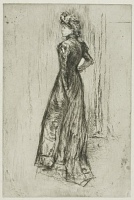Maud, Standing | ||
| Number: | 169 | |
| Date: | 1876-1878 | |
| Medium: | etching and drypoint | |
| Size: | 228 x 152 mm | |
| Signed: | butterfly at right (7-final) | |
| Inscribed: | no | |
| Set/Publication: | no | |
| No. of States: | 16 | |
| Known impressions: | 13 | |
| Catalogues: | K.114; M.113; W.99 | |
| Impressions taken from this plate (13) | ||
TECHNIQUE
Whistler drew the figure with repeated outlines so there is no one clear-cut outline - instead the edges of the figure are softened and although the pose is static there is a slight feeling of movement as well as a soft lustrous quality on the dress. He used both etching and drypoint and in many states also worked on the proofs in chalk, pen and wash.
PRINTING
There are one or two impressions of each of the sixteen states, not all of which have been located. The first state was printed in black ink, with considerable tone, on cream laid 'antique' (pre-1800) paper with the Arms of Amsterdam watermark (). A second state was printed on ivory laid 'antique' paper with a countermark (possibly 'FD') taken from a book, and has old, cryptic and partly illegible inscriptions in pen and ink on the verso (). 10
10: 'Eledefcryus fam grammatice memenat Gelling 13 cap 14 ... Elysnice foror fuit Gimom duce in .. .cfg ukor. Postea nupta fuit Gallice vid sep Binon-5' (?)
Several impressions were extensively worked on by the artist, either suggesting changes or making alterations. In the second state mentioned above, the tippet (over her shoulders), the back of the bodice and parts of the outlines of the front and back of the dress are drawn in pen or brush and dark brown wash, narrowing the waistline and slimming the figure.
A later impression is touched with white chalk and white or grey wash down the back of the dress and each side of the bustle (). This is interesting, since several impressions of a lithotint of Maud, The Toilet c010, dating from 1878, are similarly amended in white chalk or crayon. 11
11: Spink 1998[more] (cat. no. 10), pp. 74-77.
When Whistler revised the etching radically, in 1878 or 1879, the plate showed considerable foul biting, which has a textural pattern, suggesting that the plate had been set aside, wrapped in paper or cloth that left an 'impression' on the wax or ground protecting the plate, when work on the plate was taken up again after a longish interval (see , an impression printed in black on Asian laid paper).
